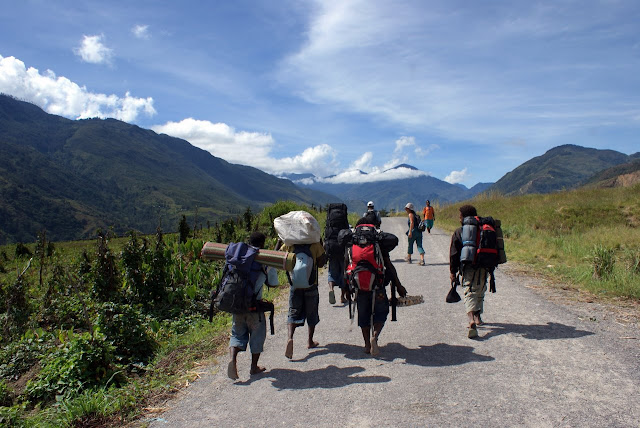Attractions In Papua
Baliem Valley
Baliem Valley, also known as the Grand Valley is located in the Central Highlands of Western New Guinea, currently part of Indonesia. Baliem Valley gains its prominence through its beautiful landscape and culturally rich inhabitants who belong to the Dani tribe. The main town in the valley is Wamena. The valley is about 80 km in length by 20 km in width and lies at an altitude of about 1,600-1,700 m. As far as the outside world was concerned, the discovery of the Baliem Valley and the unexpected presence of its large agricultural population was made by Richard Archbold’s third zoological expedition to New Guinea in 1938. On 21 June an aerial reconnaissance flight southwards from Hollandia (now Jayapura) found what the expedition called the ‘Grand Valley’. Since then the valley has gradually been opened up to a limited amount of tourism.
 |
| Baliem Valley |
 |
| Baliem Valley Tracking |
 |
| Traditional Bridge Baliem Valley |
 |
| Baliem Valley Cultural Festival |
Lorentz National Park
Lorentz National Park is the largest protected area in the Asia-Pacific region and contains Puncak Jaya (Carstensz Pyramid), which at 4,884 metres is the tallest mountain between the Himalayas and the Andes and the highest island peak in the world. Puncak Jaya is surrounded by equatorial glaciers, which are rapidly retreating due to the effects of global warming.
 |
| Cartenz Pyramid At Lorenz National Park |
Lorentz National Park is located in the Indonesian province of Papua, formerly known as Irian Jaya (western New Guinea). With an area of 25,056 km2 (9,674 mi2), it is the largest national park in South-East Asia. In 1999 Lorentz was declared a World Heritage Siteby UNESCO.
An outstanding example of the biodiversity of New Guinea, Lorentz is one of the most ecologically diverse national parks in the world. It is the only nature reserve in the Asia-Pacific region to contain a full altitudinal array of ecosystems ranging through marine areas,mangroves, tidal and freshwater swamp forest, lowland and montane rainforest, alpine tundra, and equatorial glaciers. At 4884 meters, Puncak Jaya (formerly Carstensz Pyramid) is the tallest mountain between the Himalayas and the Andes.
 |
| Lorentz National Park |
Lorentz Park contains many unmapped and unexplored areas, and is certain to contain many species of plants and animals as yet unknown to Western science. Local communities ethonbotanical and ethnozoological knowledge of the Lorentz biota is also very poorly documented.
 |
| Bird Of Paradise |
Raja Ampat
Raja Ampat is in Papua in Indonesia. The name of Raja Ampat comes from local mythology that tells about a woman who finds seven eggs. Four of the seven eggs hatch and become kings that occupy four of Raja Ampat biggest islands whilst the other three become a ghost, a woman, and a stone. The four major islands found here are Waigeo, Misool (which is home to ancient rock paintings), Salawati, and Batanta.
Located off the northwest tip of Bird's Head Peninsula on the island of New Guinea, in Indonesia's West Papua province, Raja Ampat, or the Four Kings, is an archipelago comprising over 1,500 small islands, cays, and shoals surrounding the four main islands of Misool, Salawati, Batanta, and Waigeo, and the smaller island of Kofiau.
Raja Ampat Regency is a new regency which separated from Sorong Regency in 2004. It encompasses more than 40,000 km² of land and sea, which also contains Cenderawasih Bay, the largest marine national park in Indonesia. It is a part of the newly named West Papua province of Indonesia which was formerly Irian Jaya. Some of the islands are the most northern pieces of land in the Australian continent.
 |
| Raja Ampat Resort |
In Raja Ampat, you can see different types of fish and corals. Raja Ampat is the place where coral species reach 75% of all known species and fish nearly 1,300 species.
The Raja Ampat islands are a truly natural phenomenon with enormous biological diversity. The amazing marine landscape means that underwater photography should be on the top your list during your stay.
 |
| Coral Reef At Raja Ampat |
 |
| Fish At Raja Ampat |
However with Raja Ampat’s natural conditions, high endemic level of land, sea biodiversity, coastal ecology, and local culture & tradition the islands offer more than just amazing landscapes to photograph.
Photo Raja Ampat Background
|











0 komentar: